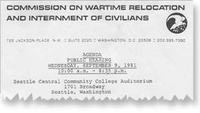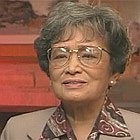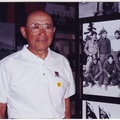"I am very happy that the government of America is looking into the past. I think it takes a great country to admit its mistakes and make proper restitution."
--Masao Takahashi
In retrospect, the success of the Japanese American redress movement seems like a historical inevitability. In reality, the struggle for justice stretched over three decades and was anything but assured. Just as the mass removal and incarceration of 120,000 Japanese Americans without charge or trial was itself not inevitable,1 the government's acknowledgment of the mass injustice and awarding of monetary compensation were far from automatic. President Reagan's signing of the Civil Liberties Act of 1988 completed the quest for public recognition of the wrongs suffered by lawful Japanese immigrants and their citizen children in the 1940s. This hard-fought legislation led to a presidential apology, payment of $20,000 to each survivor of the incarceration camps, and funds for public education programs about the mass violation of constitutional rights. Original documents recently entered in the Densho Digital Archive indicate the critical role played by Seattle activists in bringing about a modicum of justice for countless tragic losses.
In the early 1970s, a period of broadening demands for civil rights, Japanese Americans on the West Coast started to question their silence about the World War II incarceration and the resulting social, financial, and psychological damage. Various committees of the Japanese American Citizens League (JACL) and unaffiliated groups proposed competing plans for apologies and compensation. At first lukewarm in its support of redress, the national JACL recommended block grants to be disbursed to Japanese American organizations, while others -- including the Seattle Evacuation Redress Committee of the JACL -- called for reparations to individual survivors of the camps.
Complicating the work of redress activists was the resistance they encountered among their fellow Nikkei (Japanese Americans), who feared reprisals for even raising the issue. Densho interviewee Henry Miyatake, an early champion of redress, recalls the surprising response to the proposal he and the JACL chapter president put forth:
And we put it to a vote in Seattle chapter and they adopted the plan that we set forth. And then he tried to get the Northwest Regional District Council to support it and we had a -- we set up two days for the education of these people because this was a problem: educating Japanese Americans. It's a issue that, they really don't understand the terms of the constitutionality of the process that we went through. And the people that I thought we would have the easiest time, it turned out to be the most difficult. And this was surprising to me. I thought these guys, they're smart enough to understand the Constitution and all this kind of material. They were able to understand the Hirabayashi case. So I thought for sure that these guys would be supportive, but they turned out to be the worst opposition.
Well, there's two strong opposition functions. One is that they thought we would rock the boat. This is a very controversial issue, especially when we demand monies from the U.S. Congress for damages that were done to us. And it would damage the reputation and integrity of Nikkei Americans. That was one point of view. And the other was, you're demeaning the character of Japanese Americans to go after money. And maybe the other point of view was saying, "Hey, we're making enough progress. Don't do anything that would prevent us from making more progress."
The multiple prongs of the redress movement advanced through the years. In 1979, the JACL National Committee for Redress began pushing for the creation of a government commission to study the incarceration and recommend solutions. At the same time, others lobbied national legislators to sponsor redress bills, community members raised awareness through pilgrimages to the former camps, and volunteer lawyers sought to reopen the wartime Supreme Court cases that had upheld the mass detention.2
The turning point of the redress movement came in July 1980, when Congress created the Commission on Wartime Relocation and Internment of Civilians (CWRIC). This bipartisan panel went on to examine a vast number of historical documents and hear 750 testimonies in ten cities. A JACL leader in Seattle, Cherry Kinoshita (Densho interviewee and donor of the CWRIC documents), helped to inform the community about the hearings to be held in September 1981 and prepare them for the emotionally difficult prospect of testifying:
So we set a date -- it was in May -- and we went through some workshops to get people into the habit of, into the ease of testifying. And in that process, we found three very, very tragic stories. One represented a loss of property. This fellow had acreage in the Olympic Peninsula area and he totally lost it because of taxes. And it was just an outright loss and that was really quite tragic because that was all his life's savings and whatever, involved in that. Another one was Theresa Takayoshi who was in our committee and she was a mixture of Irish and Japanese. Her name was Takayoshi, well that was her married name. But she had been married when the evacuation came. She had the choice of going or not going to camp but they had children and no way, she said, would she want to be parted from her children, so she chose to go to camp. While she was in camp, in Puyallup, her little boy got sick and they took him out to the hospital and then she, she had to go and come back to camp each day. But she went to visit and once she overheard a nurse saying to another one, "Let's let that little Jap kid die." And that was just really tragic. And she realized, she had chosen at age fourteen to go with her Japanese background and so she associated with Niseis all along, but her story was really tragic. And then the third person that we chose to have this mock hearing was a fellow who was only about eight or nine, I think he was eight. He was caught in Alaska with his father, and the FBI came immediately and picked him up. Left him all alone, I mean, there was no one else. So some neighbors and all sort of took him in and they were, the Alaskan people were shipped down to Puyallup. And here he was, an orphan, in essence, and he had to bunk with the single -- some of them Issei men. And this little child, he told a real touching story about, he didn't realize what he could do with his socks and they kept getting dirtier and dirtier until somebody told him you know, "You could go to the laundry room and wash 'em." But he didn't know. I mean he was a little kid. And he told these stories about how he had to struggle, and it was so heart-wrenching.
The commission's definitive report, Personal Justice Denied ,3 published in 1982, concluded that the incarceration was not justified by military necessity but was rooted in war hysteria, racial prejudice, and a failure of leadership. The commission recommended monetary compensation for the severe losses Japanese Americans suffered. These findings set the groundwork for the redress legislation that passed and survived a threatened veto six years later.
No foregone conclusion, the apology and reparations were finally secured thanks to a handful of Nikkei legislators and a wave of lobbying by former incarcerees. Japanese Americans and their allies made over 100 congressional visits and wrote more than 20,000 letters to elected officials. Decades after having their rights as citizens denied -- with lifelong consequences -- the Nisei claimed their rights as citizens to gain a measure of justice for themselves and their Issei parents.
Beyond providing evidence for the CWRIC commissioners, the oral and written testimonies gathered in Seattle and other cities released memories the Nisei had long repressed as they went about the business of earning a living, raising children, and quietly fitting in. Their emotionally wrenching life stories, many told for the first time at the hearings, proved cathartic for the Nikkei population as a whole. Saddest of all, perhaps, were the testimonies of the elderly Issei, many of whom had died before the redress movement could vindicate them. Doing honor to that generation's stoic dignity are the words of 87-year-old Masao Takahashi:
On the very day of my eldest daughter's eleventh birthday, February 21, 1942, I was roused from my sleep very early in the morning. The FBI, along with four Seattle policemen, searched my house, ransacking closets... I was placed in the Immigration Detention Center…I am a perennial optimist and the anxiety of my fellow inmates had little effect on me. I recall feeling confident that I would be released in time to eat birthday cake with my family that evening. However, when we were stripped naked and thoroughly inspected, my optimism was shaken by the very humiliation of the process. I assumed that cooperation would lead to an early release and resolved to accept the inevitable. But that was not to be.
...After approximately a month and half, my family came to the train station when a group of us were transferred to Missoula, Montana. I was allowed a few minutes to walk to the fence to say goodbye to them. I was at loss to find comforting words. Boarding the train, I heard my daughters crying out, Papa, Papa. I cannot describe how I felt at that time. I can still hear the ring of their crying in my ears today. This was the first time it occurred to me that I might not see them again...Today, aside from my old age affirmities, I am very comfortable in my late years. Despite the fact that I was unable to give my daughters the support I wanted to in their growing years, they have given so freely of their time and resources to keep me comfortable. My beautiful eight grandchildren are a great comfort to me. I live as a lord in my old age, due to their grace and largely at their grace. I am very happy that the government of America is looking into the past. I think it takes a great country to admit its mistakes and make proper restitution. America has that greatness.
1. See Greg Robinson, By Order of the President: FDR and the Internment of Japanese Americans (Cambridge, Mass. and London: Harvard University Press, 2001), for an analysis of the president's decision to incarcerate Japanese Americans despite intelligence reports that they did not pose a security threat.
2. Peter Irons, Justice at War: The Story of the Japanese American Internment Cases (Berkeley: University of California Press, 1983).
3. Commission on Wartime Relocation and Internment of Civilians. Personal Justice Denied: Report of the Commission on Wartime Relocation and Internment of Civilians . 1982. Seattle: University of Washington Press, 1997.
* This article was originally published on the Densho's Online Archives in September 2007.
© 2007 Densho









